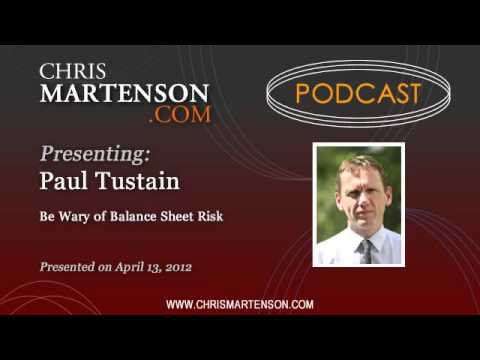"I always tell people when they look at their bank account, they think they have got maybe $50,000 in the bank. It says $50,000 CR. Credit.
You are a creditor. It is the bank’s property, that $50,000. And they recognize in that document that they owe it to you.
So, you have to watch out for that word 'creditor'. When you see CR, you are on the balance sheet. You are at risk."
So says Paul Tustain, founder of BullionVault and advocate for minimizing counterparty risk in a world of rehypothecation and 100-to-1 leveraged paper markets.
In this interview, Chris and Paul discuss gold's current range-bound trading. In general, he's in favor of a stay-the-course approach for bullion investors at the moment as world markets work through their liquidity-induced "sugar highs":
I do not think there has been a great change in the fundamentals. I think we know pretty much what is going on:
We have ongoing quantitative easing. It may or may not come again. The markets get bored of doom and gloom. People get bored of it. We had a bellyful of it over the back end of last year. Certainly the economic data out of the US is better than it was. That is happening again at a backdrop of an extremely loose monetary policy. So, we are in a world where the Europeans have given an almighty kick of the can down the road: a one trillion Euro reflation effect on the European banking system. That will come back to haunt us in a big way before long.
They are already starting to worry again about Spain and certainly in a year or 18 months we will have to have a long, hard look at Italy again. By then it will only be 18 months until all that money has to be paid back again. In the meantime, we are looking at a banking sector that has got all the same problems as before.
But markets do this. They have a certain rhythm. I do not think the fundamentals have changed. I certainly do not think anything has been fixed. Sometimes you have to be patient.
Chris and Paul also spend a lot of time discussing price manipulation in the metals markets, the perplexing difference in price action in the US spot market vs the overnight international "fixes", and counterparty risk within the futures exchanges.
Click the play button below to listen to Chris' interview with Paul Tustain of BullionVault (runtime 36m:52s).
iTunes: Play/Download/Subscribe to the Podcast
Download/Play the Podcast
Report a Problem Playing the Podcast
Or click here to read the full transcript.
BullionVault's Director, Paul Tustain, founded BullionVault as a response to a widespread perception of increasing systemic risk in the financial world. He remains in full day-to-day control, and in his view global systemic risk has become still more acute. He is committed to directing the business in such a way that at every step it retains its first objective of using gold to secure customers against the threats in the international financial system. He is also the editor and publisher of Galmarley.com, a well-regarded and free educational resource for prospective gold buyers.
Our series of podcast interviews with notable minds includes:
- Khosla Ventures
- Charles Biderman
- Gretchen Morgenson
- Chris Martenson (answers your questions - part 2)
- Marc Faber
- Robert Mish
- Erik Townsend
- Ben Davies
- Jim Rickards
- Chris Martenson (answers your questions)
- Charles Eisenstein
- James Dines
- John Mauldin
- Jack Keller
- Rick Rule
- Robert Rapier
- Gordon Chang
- Turd Ferguson
- Eric Janszen
- Paul Brodsky
- Carolyn Baker
- David Stockman
- Rob Hopkins
- Joel Salatin
- Charles Hugh Smith
- Frank Barbera
- Nate Hagens
- David Morgan
- James Turk
- Eric Sprott
- John Rubino
- Addison Wiggin
- Simon Black
- Axel Merk
- Paul Tustain
- Francis Koster
- Dogs_In_A_Pile
- Bud Conrad
- John Williams
- Robert McFarlane
- David Collum
- Joe Saluzzi
- Jim Rogers
- Bill Fleckenstein
- Marc Faber
- Willet Kempton
- Dan Ariely
- Ted Butler
This is a companion discussion topic for the original entry at https://peakprosperity.com/paul-tustain-be-wary-of-balance-sheet-risk-3/

